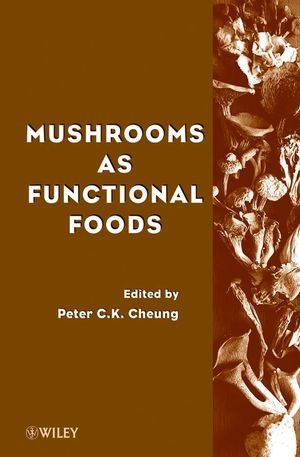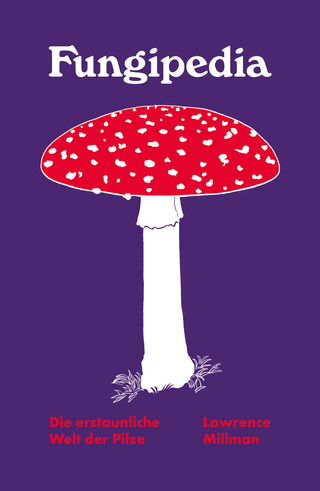
Mushrooms as Functional Foods
Wiley-Interscience (Verlag)
978-0-470-05406-2 (ISBN)
- Lieferbar
- Versandkostenfrei
- Auch auf Rechnung
- Artikel merken
Food scientists will dig into this robust reference on mushrooms
Mushrooms as Functional Foods is a compendium of current research on the chemistry and biology, nutritional and medicinal value, and the use of mushrooms in the modern functional foods industry. Topics covered range from the agricultural production of mushrooms to the use of molecular biological techniques like functional genomics; from nutritional values of newly cultivated mushroom species to the multifunctional effects of the unconventional form of mushroom (sclerotium); from the physiological benefits and pharmacological properties of bioactive components in mushrooms to the regulation of their use as functional foods and dietary supplements in different parts of the world. With contributions from leading experts worldwide, this comprehensive reference:
* Reviews trends in mushroom use and research, with extensive information on emerging species
* Includes coverage of cultivation, physiology, and genetics
* Highlights applications in functional foods and medicinal use
* Covers worldwide regulations and safety issues of mushrooms in functional foods and dietary supplements
* Discusses the classification, identification, and commercial collection of newly cultivated mushroom species
* Features a color insert with photographs of different types of mushrooms
This is an integrated, single-source reference for undergraduates majoring in food science and nutrition, postgraduates, and professional food scientists and technologists working in the functional food area, and medical and health science professionals interested in alternative medicines and natural food therapies.
PETER C.K. CHEUNG, PhD, is the Director of Studies for the Food and Nutritional Sciences Programme in the Department of Biology at the Chinese University of Hong Kong. Professor Cheung is the author or coauthor of more than 150 publications (including journal articles, patents, technical papers, and conference abstracts). He is a current member of the editorial board of the International Journal of Medicinal Mushrooms and a member of the advisory committee of the Journal of Agricultural and Food Chemistry and a member of the board of Journal of Food Composition and Analysis.
Foreword xv
Preface xvii
Acknowledgments xix
Contributors xxi
1 Overview of Mushroom Cultivation and Utilization as Functional Foods 1
Shu-Ting Chang
1.1. Introduction 1
1.2. What Are Mushrooms? 3
1.2.1. Definition of a Mushroom 3
1.2.2. Ecological Classification of Mushrooms 4
1.2.3. Identification of Mushrooms 4
1.3. Concept of Mushroom Biology and Applied Mushroom Biology 6
1.3.1. Mushroom Biology 6
1.3.2. Applied Mushroom Biology 7
1.3.3. Impact of Applied Mushroom Biology 9
1.3.3.1. Nongreen Revolution 9
1.3.3.2. Mushroom Bioremediation 11
1.4. Mushroom Cultivation 11
1.4.1. Major Phases of Mushroom Cultivation 12
1.4.2. Cultivation of Several Selected Mushrooms 13
1.4.2.1. Cultivation of it Agaricus 14
1.4.2.2. Cultivation of Lentinula edodes 14
1.4.2.3. Cultivation of Pleurotus sajor-caju 17
1.4.2.4. Cultivation of Volvariella 17
1.4.2.5. Cultivation of Agaricus brasiliensis 18
1.4.2.6. Cultivation of Ganoderma lucidum 19
1.4.3. Utilization of Mushroom Germplasm 20
1.5. World Mushroom Production 21
1.6. Mushroom Biotechnology 23
1.6.1. Nutritional and Medicinal Value of Mushrooms 23
1.6.2. Nutriceuticals and Dietary Supplements 24
1.7. Development of World Mushroom Industry Movements 25
1.7.1. International Movement for Edible Mushrooms 26
1.7.2. International Movement for Medicinal Mushrooms 27
1.7.3. International Movement for Wild Mushrooms 27
1.8. Concluding Remarks 28
References 29
2 Molecular Analysis and Genomic Studies of Shiitake Mushroom Lentinula edodes 35
Hoi-Shan Kwan and Winnie W. Y. Chum
2.1. Introduction 35
2.2. Isolation of Genes 36
2.2.1. Growth 36
2.2.1.1. Substrate-Utilizing Genes 36
2.2.2. Development 37
2.2.2.1. Mating-Type Genes 38
2.2.2.2. Genes Differentially Expressed in Dikaryotic Mycelium 38
2.2.2.3. Genes for Initial Fruiting Bodies/Primordium Formation 38
2.2.2.4. Genes for Mature Fruiting Bodies Formation 44
2.2.3. Physiological Processes in Lentinula edodes 47
2.2.3.1. Signal Transduction 47
2.2.3.2. Energy Production 47
2.2.3.3. Structural Proteins in Development 48
2.3. Molecular Genetics 48
2.3.1. Generation of Markers 49
2.3.2. Typing/Fingerprinting 50
2.3.3. Genetic Mapping 50
2.4. Functional Genomic Approaches for Gene Expression Analysis 50
2.4.1. Differential Display: RAP-PCR 51
2.4.2. cDNA Representation Difference Analysis 52
2.4.3. SAGE and LongSAGE 52
2.4.3.1. SAGE Profiles: Mycelium to Primordium 53
2.4.3.2. SAGE Profiles: Fruiting Bodies 53
2.4.4. cDNA Microarray 53
2.4.5. Expressed Sequence Tag 54
2.4.6. Yeast Two-Hybrid System 54
2.4.7. Sequencing-by-Synthesis Approach (454 Life Science) 54
2.5. Transcriptional Regulation 55
2.5.1. Transcriptional Factors 55
2.5.2. Promoter Analysis 55
2.6. Transformation 56
2.6.1. Transformation Methods 56
2.6.1.1. PEG-Mediated Transformation 56
2.6.1.2. Restriction Enzyme–Mediated Integration 57
2.6.1.3. Others 58
2.6.2. Lentinula edodes Genes Used in Transformation 58
2.7. Process Analysis 59
2.7.1. Postharvest Studies 59
2.7.2. Stress Responses 59
2.7.2.1. Studies of Temperature Stress in Mushrooms 59
2.7.2.2. Studies of Molecular Chaperones in Fungi 59
2.7.3. Lignocellulose Degradation 60
2.7.4. Meiosis 60
2.8. Conclusion 61
References 61
3 Nutritional Value and Health Benefits of Mushrooms 71
Peter C. K. Cheung
3.1. Introduction 71
3.2. Wild and Cultivated Edible Mushrooms 72
3.3. Production of Cultivated Mushrooms 72
3.4. Nutritional Composition 73
3.4.1. Conventional Edible Mushrooms 73
3.4.1.1. Moisture 73
3.4.1.2. Protein and Amino Acids 74
3.4.1.3. Fat 75
3.4.1.4. Ash and Minerals 75
3.4.1.5. Vitamins 76
3.4.1.6. Dietary Fiber 77
3.4.1.7. Carbohydrates 78
3.4.1.8. Energy 78
3.4.1.9. Other Components 78
3.5. Newly Cultivated/Nonconventional Mushrooms 79
3.6. Nutritional Evaluation 80
3.6.1. General Aspects 80
3.6.2. Biological Methods for Nutritional Evaluation 80
3.6.3. Mushroom Protein Quality 87
3.7. Health Benefits of Edible Mushrooms 89
3.7.1. General Aspects 89
3.7.2. Antioxidants in Mushrooms 89
3.7.2.1. Bioactive Components and Their Antioxidative Activities 89
3.7.2.2. Characterization of Mushroom Phenolic Antioxidants 91
3.7.2.3. Biosynthesis of Phenolic Compounds from Mushrooms or Fungi 93
3.7.3. Hypocholesterolemic Effect of Mushrooms 94
3.7.4. Hypoglycemic Effect of Mushrooms 97
3.8. Conclusion 99
References 99
4 Sclerotia: Emerging Functional Food Derived from Mushrooms 111
Ka-Hing Wong and Peter C. K. Cheung
4.1. Introduction 111
4.2. Concepts of Mushroom Sclerotia 112
4.3. Ontogeny of Sclerotia 112
4.3.1. Morphological Aspects 112
4.3.2. Physiological Aspects 114
4.3.2.1. Translocation 114
4.3.2.2. Exudation 115
4.4. Structure of Sclerotia 115
4.4.1. Rind 115
4.4.2. Cortex 116
4.4.3. Medulla 117
4.5. Cultivation of Mushroom Sclerotia 117
4.5.1. Sclerotia of Pleurotus tuber-regium (Fries) Singer 118
4.5.2. Sclerotia of Polyporus rhinocerus Cooke 119
4.5.3. Sclerotia of Wolfiporia cocos (Schw.) Ryv. Et Gilbn [Poria cocos (Schw.) Wolf] 120
4.6. Biochemical, Nutritional, and Technological Characteristics of Mushroom Sclerotia 121
4.6.1. Biochemical Components of Mushroom Sclerotia 121
4.6.1.1. Cell Walls 121
4.6.1.2. Extracellular Matrix 122
4.6.1.3. Cytoplasmic Reserves 122
4.6.2. Nutritional Evaluation of Mushroom Sclerotia 123
4.6.2.1. Proximate Composition 123
4.6.2.2. Sclerotial Dietary Fiber 124
4.6.3. Physicochemical and Functional Properties of Mushroom Sclerotial DF 126
4.7. Biopharmacological Values of Mushroom Sclerotia of P. tuber-regium, P. rhinocerus, and W. cocos 128
4.7.1. In Vitro Mineral Binding Capacity 128
4.7.2. In Vitro Fermentability 129
4.7.3. In Vivo Ca and Mg Absorption 131
4.7.4. Antitumor and Immunomodulatory Activities 132
4.8. Conclusion 134
References 134
5 Antitumor and Immunomodulatory Activities of Mushroom Polysaccharides 147
Vincent E. C. Ooi
5.1. Introduction 147
5.2. Antitumor Polysaccharides from Mushrooms (Higher Fungi) 149
5.3. Mechanisms of Antitumor Action of Mushroom Polysaccharides 153
5.3.1. Antiproliferation of Cancer Cells and Induction of Apoptosis 153
5.3.2. Immunomodulation 161
5.3.2.1. Effects of Mushroom Polysaccharides on Macrophages and Spleen Cells 163
5.3.2.2. Effects of Mushroom Polysaccharides on NK Cells 167
5.3.2.3. Effects of Mushroom Polysaccharides on DCs 168
5.3.2.4. Effects of Mushroom Polysaccharides on Hematopoietic Stem Cells 170
5.3.3. Antimetastasis 171
5.3.4. Antiangiogenesis 172
5.4. Structure and Antitumor Activity Relationship of Polysaccharides 173
5.4.1. Effect of Molecular Mass 174
5.4.2. Impact of Branching Configuration 174
5.4.3. Relationship of Antitumor Activity and Conformation 175
5.4.4. Improvement of Antitumor Activity by Chemical Modifications 176
5.5. Conclusions 178
References 179
6 Regulatory Issues of Mushrooms as Functional Foods and Dietary Supplements: Safety and Efficacy 199
Solomon P. Wasser and Eden Akavia
6.1. Introduction 199
6.2. Legal and Regulatory Issues of Introducing and Controlling Dietary Supplements from Medicinal Mushrooms in Different Countries 202
6.2.1. World Health Organization Guidelines 202
6.2.2. Codex Alimentarius 202
6.2.3. United States 203
6.2.4. European Union 208
6.2.5. Canada 210
6.2.6. Australia and New Zealand 212
6.2.7. Japan 213
6.2.8. Israel 215
6.3. Safety and Diversity of Dietary Supplement Types from Culinary–Medicinal Mushrooms 216
6.4. Submerged Culturing as Best Technique for Obtaining Consistent and Safe Mushroom Products 220
6.5. Experiences of Seven Countries in Consolidating Their Food Safety Systems 220
6.6. Summary 221
References 221
Index 227
| Erscheint lt. Verlag | 10.10.2008 |
|---|---|
| Sprache | englisch |
| Maße | 163 x 241 mm |
| Gewicht | 553 g |
| Themenwelt | Naturwissenschaften ► Biologie ► Mykologie |
| Technik ► Lebensmitteltechnologie | |
| Weitere Fachgebiete ► Land- / Forstwirtschaft / Fischerei | |
| ISBN-10 | 0-470-05406-9 / 0470054069 |
| ISBN-13 | 978-0-470-05406-2 / 9780470054062 |
| Zustand | Neuware |
| Haben Sie eine Frage zum Produkt? |
aus dem Bereich


